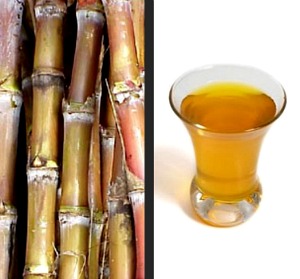 Vinegar is a versatile liquid use in some food preparation, as an ingredient and condiment. The key ingredient of vinegar is acetic acid, which gives it an acidic taste. There are many different types of vinegars, depending on what liquid the ethanol has been fermented in, and one of which is the Cane vinegar.
Vinegar is a versatile liquid use in some food preparation, as an ingredient and condiment. The key ingredient of vinegar is acetic acid, which gives it an acidic taste. There are many different types of vinegars, depending on what liquid the ethanol has been fermented in, and one of which is the Cane vinegar.
Cane vinegar are made from sugar cane juice and one of the most popular in the Philippines, particular in the Ilocos Region of the northern Philippines where it is called “Sukang Iloko”. It ranges from dark yellow to golden brown in color, and has a mellow flavor, similar in some respects, to rice vinegar, though with a somewhat “fresher” taste. Contrary to expectation, containing no residual sugar, it is not sweeter than other vinegars. In the Philippines, it often is labeled as sukang maasim, although this is simply a generic term meaning “sour vinegar”.
Cane vinegar is used in dishes with sweet and sour sauces, and surprisingly, in many dishes that are certainly not Philippine in origin. In Philippine cooking, one of the classic dishes is adobo and paksiw na pata, usually made with several cups of this alternate vinegar. Some people like to add a touch to dressings for fruit salads since it will have bite but won’t interfere with natural fruit flavors.
Moreover, vinegar can be more than an addition to any dish–it can be a source of income—a promising business venture for any Filipino who is interested in making more money at home. The Sugar Regulatory Administration (SRA) has packaged a fast, easy-to-follow and cost effective technology on making vinegar. This technology produces naturally fermented sugarcane vinegar from sugarcane juice in just two weeks.
How to make Sugar Cane Vinegar or Sukang Iloko
Materials
Making vinegar provides an avenue for utilizing over-riped fruits, sugarcane rejects, ethyl alcohol rejects and cane by-products such as molasses, bagasse and tops.
In the Visayas, southern Tagalog areas and Central Luzon, the most common materials used for vinegar making are nipa palm sap, coconut palm sap, pineapple juice and sugared coconut water. However, in sugar areas where leftover canes rejected by mills abound, it is recommended that these materials be utilized.
Young canes may also be used for vinegar making. If the juice extracted is below 15-16 degrees brix, small amounts of sugar are added. Molasses or muscovado can be used instead of sugar.
Procedure:
- Remove trash and wash canes.
- Crush sugarcane stalks to extract juice. To increase recovery, make two or three passes. Collect juice in earthen jars.
- Bring filtered juice to a boil or cover the earthen jars (w/juice) to high temperature. One day under the sun is enough to destroy contaminants.
- Add one-half gram (1/4 of fresh cake) of yeast per liter of juice. Reactivate yeast by hydration before addition. Stir very well. Use only wooden or bamboo spoons. Never use metallic spoons or containers.
- Allow suspended soil particles and other extraneous materials to flow over for 2-3 days. Use narrow-mouthed jars during this period of fermentation.
- You will observe that a clean amber-colored liquid will remain after suspended dirt is removed. Clean the jars’ mouths with a damp cloth. Cover jars with katsa or earthen jar cover. Air is not required at this stage of fermentation.
- Let the liquid stand for another five days. Alcoholic fermentation is a fast process, it is almost complete after 3-4 days.
- Test alcoholic fermentation with a hydrometer. If brix is zero, proceed to acetic acid fermentation, If you have no hydrometer, just take note of the movement of gases in the liquid. Once there are less gases produced, proceed to the next step.
- Transfer or siphon the liquid to wide-mouthed earthen jars. Do not include the yeast sediments. Mix four parts of the liquid with one part of good unpasteurized vinegar (mother liquor).
- Stir thoroughly. Cover with a clean piece of cloth. Repeat mixing at least twice a day. Use only wooden/bamboo ladles. Do not fill the jars up to the brim. Leave some air space. At this stage, oxygen is required by the fermenting organisms.
- Allow the liquid to ferment until acidity is strong enough (4-6% acetic acid). In one to two weeks, the vinegar is ready for bottling. Test liquid for acetic acid content in the laboratory for quality control.
- Siphon into bottles and pasteurize at 60-70 deg. C for 20 minutes, to arrest further fermentation. Label.
- Retain 1/5 of the fermented vinegar in the wide-mouthed jars for the second batch.
- Continue with the procedure a long as there are no contaminants. As soon as abnormal smell or growth of other organisms is observed, clean the jars very thoroughly and use another batch of mother liquor. If there are only a few contaminants, boil the fermented liquid and test it if it can be pasteurized and used as vinegar.
Sources: Mary Charlotte O. Fresco of BFAR Digest, wikepedia.org, wisegeek.com; Photo: meghnavillagevinegar.webs.com